Gills Harbour Planning For Pentland Firth Energy
15th May 2013
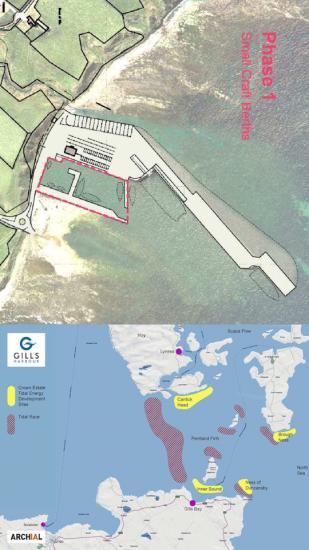
Some indicative Pentland Firth energy sketches relating to Gills Bay/Gills Harbour, Caithness, KW1 4YB.
The sketches have been drafted for Gills Harbour Ltd by Mark Fresson, a senior architect at Archial Ltd's North of Scotland office in Inverness and kindly donated to community-owned Gills company. Archial is a Toronto, Canada-based multi-national practice, with branches/associate-ships throughout the English-speaking world.
Larger Photos
Gills Harbour Phase 1
Pentland Firth Tidal Races
The company has business in Orkney and Mark is familiar with Gills Harbour as a regular traveller on the Pentland Ferries Ltd year-round thrice-daily RO:RO car-ferry Pentalina.
Mark is the grandson of 1930s North of Scotland flying pioneer Capt. Edmund 'Ted' Fresson. Fresson (1891.1963) was the pilot/director of Highland Airways Ltd, substantially owned by motor-engineering/transport firm MacRae & Dick, of Inverness, which established scheduled air services linking Inverness, Caithness and Orkney exactly 80 years ago this month (May 1933).
The first internal UK domestic air-mail letters across the Pentland Firth to Kirkwall were thanks to a Royal Mail contract awarded to the company just one year later. (May, 1934)
The first sketch shows the location of the potentially-hazardous tide-races in the Pentland Firth and the sites of sea-bed leases granted by the Crown Estate, for the purpose of generating electricity using recently-developed 'horizontal hydro' turbines.
The places on the Firth's sea-surface where white-water breaks daily year-round on the appropriate 12.5 hour tide-cycle, are shown. This is based on written information published by HM Hydrographer-Royal (Admiralty) to be read in conjunction with sea-farers' navigational charts of the area.
Wave-crests of 8 metres are commonplace in winter in the Merry Men of Mey which emanates off the Caithness coast on the W-flowing ebb tide-streams from just W of St John's Point (c.1.5 NW of Gills Harbour).
The watery phenomenon crosses the entire Firth to Tor Ness, the SW tip of the Isle of Hoy, Orkney, appropriately named by the ancient Vikings for their 'War god' Thor. Swells of up to 12 metres have been experienced by the crew of the RO:RO ferry Hamnavoe which usually plies the Firth's W Approaches between Scrabster and Stromness directly, but re-routes via the Pentland Firth & Scapa Flow when heavy Atlantic-origin winter gale-driven W swells roll in.
The 'Men' is officially described as 'the most extensive and dangerous race in the Pentland Firth'. 'In a W sea or swell the entire race becomes very violent; large waves will form very suddenly and come from varying directions, making it difficult to counter or anticipate', the Hydrographer warns.
The Merry Men of Mey forms a natural breakwater across the Firth and the official advice is that the channel can be crossed to E of the breakers (e.g. as from Gills Bay) 'in smooth conditions .... even when the race is most violent'.
The other vicious tide-race emanates off John O'Groats mainly during the E-flowing flood and is known as the Bore(s) of Duncansby, with local people preferring the singular designation for the phenomenon and never using the modern expression 'Duncansby Race'. The word 'bore' for a water-feature dates back over 1,000 years to the Viking era.
It is at its worst when opposed by short sharp E swells rolling in from the North Sea and during those times it can 'block-off' access to the Inner Sound, between the Isle of Stroma and the Canisbay parish mainland in Caithness.
The map shows the seabed leases in relation to the (often violent) tide-races, with the ports of Gills, Scrabster and Lyness marked , with Wick off the map c. 14 miles S of Duncansby Head.
The second drawing (broadly) shows Pentland Ferries Ltd's planned 60 metre extension to the main Gills Harbour's main deep-water breakwater/berth.
As with the present breakwater, this is being created by recycling a redundant WWII one-time floating break-water, using thousands of tonnes of dredged Caithness flagstone bedrock-spoil as ballast. Construction work is due to start this month (May, 2013).
A ships' turning circle, measuring c. 100 metres x 100 metres, is to be excavated down to c. 4 metres depth at LAT (lowest astronomical tide) to the immediate E of the breakwater.
This will allow vessels of 80 metres or more to enter and egress Gills Harbour in forward motion at all times; at present the ferry has to be steered stern-wards into the the main 'linkspan' berth (the ship-to-shore 'bridge' connection) after being turned around immediately to the N of the present pier-head of the existing breakwater.
The extension will serve in an additional marine safety role.
The new extension will be 'offset' to allow marine renewables vessels to be tied up alongside without interfering with scheduled ferry movements.
The managing director of one of the UK most innovative 'marine renewables' contractors, Captain Richard Parkinson, of Mojo Maritime from Falmouth, Cornwall, has told directors of Gills Harbour Ltd and Pentland Ferries Ltd that the harbour is his company's first choice for basing it revolutionary HiFlo-4 catamaran vessel. She is expected to arrive from its builders' shipyard in the second half of 2015.
This will be the world's first purpose-built tidal stream turbine installation ship and she will be c. 12/15 metres shorter than Pentalina. Captain Parkinson, a Merchant Navy ships' master turned entrepreneur, os familiar woith the Pentland Firth and other sea-areas of the Far North in winter conditions; he used to Captain a specialist supply vessel in the deep-water sub-sea oil & gas-fields off the W of Shetland, known as the 'Atlantic Frontier'.
The dredged area in the Inner Basin will be excavated down to c. 3 m/3.5 metres to cater for small powerful 'multi-cat' work-boats/tugs of c. 25 metres, such as Leask Marine Ltd's C-Odyssey and C-Salvor, both of which have used Gills Harbour, as has ScotMarine Ltd's Orcadia.
Those and other marine contractors want to base their vessels at Gills Harbour, as this is the only Mainland port that can guarantee access to the seabed electricity-generating sites without the need to cross (i.e. 'transit') any of the strait's tide-races as can be seen in the sketch-map.
As with offshore oil, it will be marine engineering contractors who will deliver the power for the CE seabed lessees, mainly utility companies.
MeyGen Ltd, which holds the Inner Sound sub-sea electricity-generating concession between 1 and 1.5 miles from Gills Harbour's entrance, has signified that it intends to use Mojo Maritime Ltd for turbine installation and retrieval there, with an eventual total of almost 400 devices b y 2020/1.
Larger Photos
Gills Harbour Phase 1
Pentland Firth Tidal Races
Related Businesses
Related Articles
Three Cats At Gills Harbour
Two catamaran work-boats berthed at Gills Harbour this week with the trans-Pentlnd ferry MV Alfred, also a catamaran, in the background. The larger workboat is MPC Athenia which was being used as a floating base or ROVs - remote underwater vessels, for detailed inspections on the three turbines operating at the MeyGen demonstration subsea site one and a half miles off Gills Harbour.
GILLS HARBOUR Ltd ANNUAL GENERAL MEETING
GILLS HARBOUR Ltd - ANNUAL GENERAL MEETING at JOHN O'GROATS VILLAGE HALL, MONDAY JUNE 13th @ 7.30 PM. GILLS HARBOUR IS THE ONLY OFFICIALLY-RECOGNISED 'ECONOMIC DEVELOPMENT AREA' IN NE CAITHNESS.Latest Boats At Gills Harbour For Work At Meygen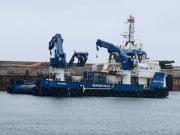
£10 million 'Isle of Jura' temporarily based at Gills Harbour in Far North of Scotland for her crew's debut tasks in the tidal-stream electricity field at the MeyGen sub-sea site, one mile off the little Caithness's port entrance channel. One of the UK's most modern marine renewables service vessels made her debut calls at community-owned Gills Harbour, near John O'Groats, over the 2021 Spring Equinoctial weekend.
Busy Gills Harbour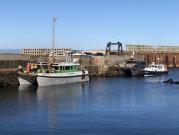
Its been a busy few days at local community-owned Gills Harbour ..... sometimes in suberb sunny weather as here ...
Energy Developments Continue at Gills Harbour and the Pentland Firth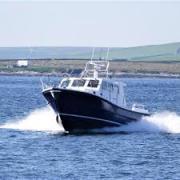
The company behind the world-leading tidal-stream prototype power plant in the Pentland Firth's Inner Sound is set to start manufacturing a new-style turbine that is hopes will reduce the project's generating costs. Simec Atlantis Energy (SAE) and a privately-owned specialist engineering firm from Spain's Bay of Biscay coastline have jointly been conducting 'research and development' (R& D) on the project for almost a year and are now ready to give it the go-ahead.
New Generation of office-bearers set to step up at Gills Harbour Ltd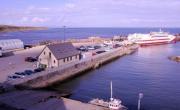
A new generation of younger local folk look set to take over the reins of running Gills Harbour Ltd, the local company that owns and operates the busy little port on the shores of the Pentland Firth's Inner Sound that holds its AGM this Saturday (10.10.20) morning at 10:00 am. The influx of younger blood comes after two key directors of the group that had run 'Canisbay's Peoples Port' both announced their retirement from office, whilst another Gills Harbour Ltd (GHL) office-bearer has declined to seek re-election.
MV Alfred And MV Pentalina Together At Gills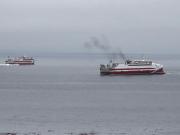
An 'old friend' returns to Gills Bay after an absence of manymonths. The 2,400 tonne 70 m.
Normand Cutter, The Norwegian-owned Offshore Construction Vessel at Gills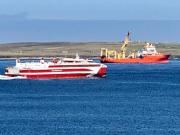
Here is the Normand Cutter, the Norwegian-owned offshore construction vessel that has been the base for works on Simec Atlantis Energy's (SAE's) MeyGen site in the Pentland Firth's Inner Sound, off Gills Bay during the current neap-tide sequence, that has lasted most of the week commencing 11.08.20. Picture by retired C of S Kirk Minister the Rev Lyall Rennie, who lives at Lower Warse, Canisbay, on the shores of Gills Bay..
New Ferry For Pentland Ferries Arrives Safely
Scotland's most modern + environmentally-friendly, fuel-efficient ROPAX ferry ship rge MV Alfred, arrived AM today (Wed 09.10.19 at St Margarets Hope. The boat went round to Kirkwall immediately at the end of 9,000+ miles voyage from the Strategic Marine yard near Ho Chi Minh city (ex.
Gills Harbour Ltd Awards Contract To Local Firm
Gills Harbour Ltd, the community-owned body that owns & operates the busy little port on Caithness's North Coast, has awarded a remedial contract to a Wick-based company. The deal, won in a competitive tender, has gone to builders/civil engineers Messrs GMR Henderson Ltd, of Martha Terrace in Wick.
